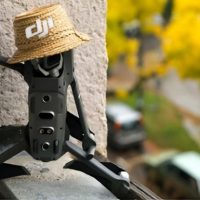Have you ever wondered if drones can brave the rain or if you are flying the drone and the rain starts? That’s where you desperately want to know: can a drone fly in the rain? Rain is one tricky obstacle for these high-flying gadgets. Let’s explore whether drones can handle a drizzle or a downpour and what precautions you might need to take. So, if you’re eager to know if your drone can soar through the raindrops or if you should keep it grounded on wet days, keep reading for all the answers you need.
Can drones fly in the rain?

Normal drones can not fly in the rain. Rain poses several risks to both the drone and its flight performance. Water can damage sensitive electronic components, interfere with sensors, and disrupt the drone’s stability and control. Raindrops on the camera lens can obscure vision, affecting navigation and image quality.
Wet conditions increase the risk of electrical short circuits and corrosion in the drone’s internal circuitry. To safeguard your drone and ensure safe operations, it’s advisable to avoid flying in the rain or invest in a waterproof drone specifically designed for wet conditions.
Can you fly a DJI drone in the rain?

DJI drone manufacturer does not recommend flying their drones in the rain. DJI drones are not designed to withstand wet conditions, and exposure to rain can lead to various issues, such as damage to the electronic components, sensor malfunctions, reduced flight stability, and potential safety hazards. Operating a DJI drone in the rain could void warranties and risk permanent damage.
What to do if it starts raining while you’re flying?
If rain surprises you mid-flight with your drone, don’t panic! Quickly bring it down to a safe landing spot. Turn off the drone and detach the battery to avoid electrical trouble. Wipe it dry, paying attention to the camera and sensors.
Check for damage and let it dry indoors for 1-2 days. Afterwards, fire it up and inspect all parts.
Remember, flying in rain can harm your drone’s electronics and sensors, so it’s best to steer clear of wet conditions when you can.
What is the IP rating for flying a drone in the rain?
When flying a drone in the rain, the Ingress Protection (IP) rating is essential.
An IP rating consists of two numbers, indicating the level of protection against solid particles and moisture.
A drone with an IP rating of at least IPX4 or higher is recommended for flying a drone in the rain.
IPX4
This rating means the drone is protected against splashing water from any direction. It can handle light rain and drizzle but isn’t suitable for heavy downpours.
Higher Ratings (IPX5 or IPX6)
Drones with these ratings offer better protection against heavy rain and are more suitable for flying in adverse weather conditions.
Is My Drone Waterproof or Water-resistant?

Determining whether your drone is waterproof or water-resistant involves examining its design, specifications, and manufacturer’s guidance.
Water-Resistant Drones
These drones can somewhat handle light rain and moisture but aren’t fully waterproof. They lack a specific IP (Ingress Protection) rating.
Look for features like sealed compartments and gaskets around openings, which provide some protection against water ingress. The manufacturer may suggest flying in light rain but advises against exposure to heavy rain or submersion.
Waterproof Drones
These drones are designed to operate in wet conditions with confidence. They have a specific IP rating, such as IPX4 or higher, indicating their level of water protection. These drones can handle heavy rain, splashes, and even brief submersion.
A waterproof drone handles heavy rain and brief submersion. In contrast, a water-resistant drone offers limited protection against light rain and moisture but is not suitable for heavy rain or immersion.
How does rain affect drones?
Rain can adversely affect drones in several ways.
- Water can damage sensitive electronic components, leading to malfunctions or permanent damage.
- Raindrops on sensors can disrupt their accuracy, affecting navigation and obstacle avoidance.
- Rain on the camera lens can obscure vision, affecting image quality and remote piloting.
- Wet conditions can reduce flight stability, making it challenging to control the drone accurately.
- Exposure to moisture increases the risk of electrical short circuits and corrosion in the drone’s circuitry.
How can you protect a drone from the rain?
Always monitor the weather forecast before flying and avoid flying in rainy conditions whenever possible. Use a rain cover designed for drones or an umbrella to shield your drone from raindrops during flight.
Some drones come with waterproof cases that provide full protection. Invest in one if your drone supports it. If rain starts unexpectedly, land the drone immediately to prevent damage.
Dry the drone thoroughly after flying in light rain with a cloth to remove moisture and prevent damage. Consider purchasing a drone with water-resistant features or a high IP rating if you frequently fly in wet conditions.
Regularly inspect and maintain your drone, especially after flying in damp conditions, to prevent long-term damage.
Jose E. Johnson is a true tech prodigy whose lifelong passion for technology and gadgets has blossomed into remarkable drone expertise. From the moment he laid eyes on his first electronic toy as a child, Jose was captivated by the limitless possibilities of innovation. As he grew, so did his fascination with cutting-edge tech, leading him to become a bona fide drone expert. With an insatiable thirst for knowledge, Jose delved deep into the intricacies of drone technology, amassing a wealth of technical knowledge and hands-on experience. Now, he shares his wisdom through insightful drone reviews and invaluable tips for fellow enthusiasts, making him a trusted source in the drone community.







Leave a Reply